Polymer clay stud earrings are a hot accessory right now, and everyone is either wearing them, making them or waiting for their favourite sellers to drop a collection on Etsy. If you’re new to the trend and want to get involved, here’s how to make your own…
How to make polymer clay stud earrings:
- Gather your supplies
- Choose your design and prepare your workspace
- Make the stud earrings
- Attach the stud backs
- Bake the stud earrings
- Varnish the stud earrings
- Package and store the stud earrings
Now you have the basic principles outlined, read on for a step-by-step guide to mastering the stud earring technique, with tips and tricks to help you along the way.
This post may link to online stores. If you click a link and buy something, I may get a commission. Learn more.
1. Gather your supplies

You want to begin by planning out what you will need in order to make your stud earrings.
This can be broken down into two categories:
- What you will need to make the earrings
- What you will need to package, store and potentially post the earrings if selling
I’ve created two shopping lists for you, outlining everything I used to make the heart stud earrings in this article as my demonstration, and everything I would use to ship them.
Here’s what you need to make the earrings:
- Polymer clay of your choice, I always use FIMO
- 6mm Earring stud backs with butterfly fastening
- A heart shaped clay cutter, that is larger in mm than the earring stud backs you will be attaching – the one I use is 12mm
- An acrylic rolling pin
- A clay cutting tool
- A crafting mat
- Polymer clay varnish
- A good quality brush for varnishing
- An oven and a baking tray
- Baking paper
- Something to transfer the earrings to and from the oven (I used a plate)
- A clean workspace
If you need help with your shopping list I have a buyer’s guide here, which includes a breakdown of different clays, tools and cutters.
It’s really important that you research which clay to use, and go with the one that suits your project needs the best.
I like to use FIMO, as they are versatile and offer a full range of colours. For this tutorial I’m using red, but if you want something a bit more funky FIMO offer a range of pearlescent shades, metallic shades and more, it goes on and on. There’s a block of clay in just about any colour your can imagine!
Sculpey is also an excellent brand with a wide range, as are Pardo, Kato and Cernit. I personally prefer FIMO, but don’t let that stop you from going with the brand you like the look of.
You need to find a clay suitable for beginners and more experienced crafters, so it can hold up as your skills grow and you take on more difficult projects. Feel free to check out my buyer’s guide if you want some initial help, or have a browse online for yourself and take your time deciding.
Here’s what you need to package, store and ship the earrings (if selling):
- Earring cards
- A sticker with your branding (optional)
- A cellophane sheath for the earring cards
- A sharpie for label and postage address writing
- Postage boxes
- Tissue paper to wrap the item (optional)
- A plastic storage box or set of drawers for stock keeping
Now you have your list, gather your supplies and have them laid out in front of you in your workspace.
It’s time for the next step…
2. Choose your design and prepare your workspace
Now you can choose your polymer clay stud earring design and decide how you will make it.
What colour clay would you like to use, and do you have the right cutter for the stud? Or will you make a 3D stud that you can mould with your fingers?
Once you have an idea for your design I would suggest sketching it out and keeping the paper in front of you as a reference point. It’s best to make something really simple for your first stud design, as I’m demonstrating in this article with the heart stud earrings.
There are loads of stud sized cutters out there to get you started with stud earrings. I used a heart cutter, but a simple circular cutter would work well for studs, or any other shape you prefer.
Top tip: look for fondant cutters when searching for polymer clay cutters, as there is a wider range and they’re usually small enough to create earrings.
Once you have the hang of stud making and earring making in general you can move onto some more complicated designs.
If you’re struggling for inspiration, check out these stud design ideas below:
5 Polymer Clay Stud Earring Ideas – Tutorial
Preparing your workspace
There are a few things to keep in mind when preparing your workspace:
- The size of the table you will be using
- How clean is the room and is it carpeted?
- How far will you have to carry the earrings to the oven – sounds odd but trust me, it’s a factor
- How much light you have at your workspace
- Do you have somewhere to keep your storage boxes, at the workspace?
- Is the workspace used by anyone else – e.g. is it the family dining table?
Size
First of all you’ll need a fairly decent sized table to work from, with enough space to have all of your supplies in front of you, and your crafting mat. You don’t want to be cramped when creating your design, so being organised here and choosing an appropriate space is important.
Cleanliness
Next, how clean is the room you will be working in? Polymer clay is really susceptible to picking up dust and any lint floating on the air – animal fur is the worst!
Now I have two cats and a big dog, and my house needs a good vacuum regularly. My workspace is kept away from my pets, in a non carpeted room, so I’m not kicking up any additional dust and fibres when I’m moving around my table.
Of course, work with the space you have; we don’t always have a private non-carpeted room to craft in, but keep those factors in mind and give your space a really good clean before using it.
You’ll also want to keep cleaning supplies handy to clean your crafting mat and tools, in between uses.
Distance from oven
This is definitely a factor to keep in mind when you’re creating polymer clay designs – carrying them to the oven when complete.
Will you have to balance your precious creations on a plate, and carry them up or down stairs, over children’s toys, past a big friendly dog who likes to jump?
If possible, craft your earrings in a space close to your kitchen, so you aren’t at risk dropping them on the way to the oven. It sounds obvious, but I’ve made the mistake of having my designs knocked from my hands and squashed last minute!
Top tip: carry your designs on a plate to the oven, not with your hands, as you want to avoid adding accidental fingerprints to them.
Light
You want your workspace to have a lot of natural light, so you can really see what you are doing.
You need to be able to see the true colour of the clay you are working with, have somewhere to photograph your products when they are complete, and to not risk straining your eyes making tiny details.
Have lots of natural light really helps when creating tiny crafting projects, like earrings.
Space for storage
I always think it’s best to keep your storage drawers or boxes at your workspace, as you can transfer you clay designs into them once they are finished.
You’ll need a storage space for your supplies and clay, to keep them dust free, and somewhere to store your stock once created, so keep this in mind.
Non-communal workspace
It’s best, if you can, to have a private workspace that isn’t used by others. This way you can keep it clean and organised, and have it dedicated to crafting.
If you’re using the family dining table for example, you’ll need to keep moving your stuff to and from it, and it’s going to become a pain. If this is your only option, that’s fine, but keep it in mind that you’ll need somewhere else to keep your supplies when the table is in use.
Now you’ve decided on your design and prepared your crafting space, let’s move on to crafting polymer clay stud earrings…
3. Make the polymer clay stud earrings
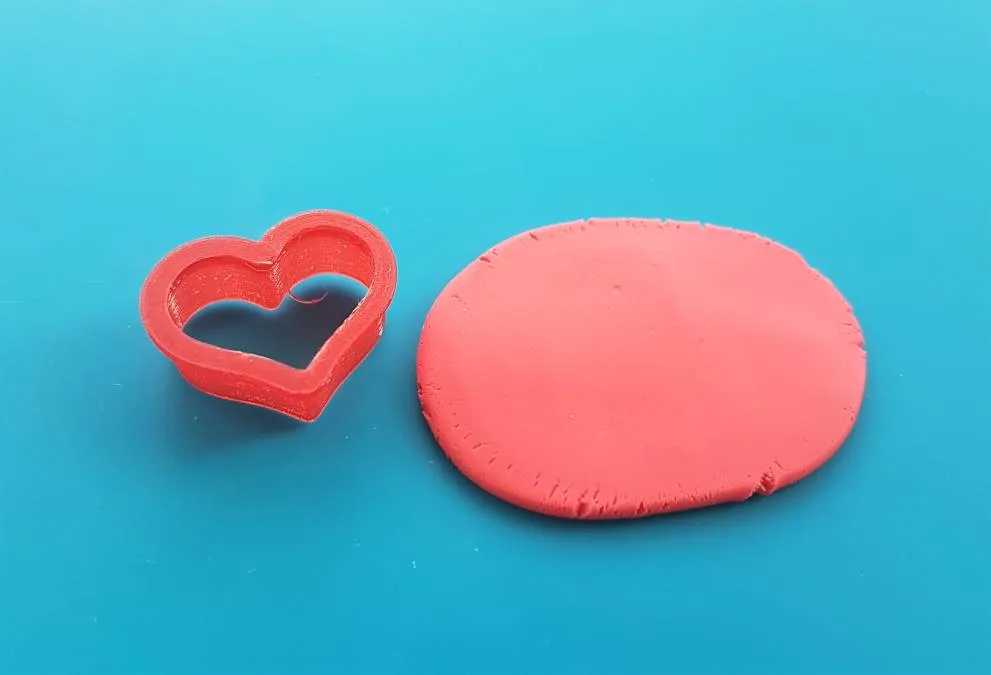
Here comes the fun part; making the earrings!
You could make these little heart designs in any colour you like, or even from a marbled slab of clay, but I decided to go with a classic red, that’s a perfect for a Valentine’s day look or for all year round. These are super simple to make, and are a great starting point for beginners. Master these, and you’ll be on to more complicated designs in no time.
Now you have your supplies ready and it’s time to get started.
Here’s a breakdown of the steps:
Prepare the clay
- Cut some red clay from your packaged block and place it on your cutting mat – if you are using a 2oz block of clay, take about 1/6 of it, which will be plenty for your earrings (if you have taken too much just pop the excess back in the packet).
- Begin to ‘condition’ the clay; warm it up between your palms or by rolling it on the mat until it forms a smooth and malleable ball. Different brands of clay take different amounts of time to condition, so keep going with yours until it feels smooth and warm.
- Take an acrylic rolling pin and roll the ball of clay until it forms a small slab, large enough for your cutter to fit into it twice. I made my slab about 1/4 inch thick.
Cut the clay
- Take your clay cutter and press it twice into the slab.
- Carefully remove the cutter by wiggling it out of the clay, so you don’t drag the rest of the slab upwards when you remove it. If you’re having trouble with this, create a few test pieces until you master using the cutter.
- Remove the clay from the cutter by pushing the clay upwards through the cutter – do it slowly with your fingertip.
- Set each piece aside and then roll two small balls from the remaining clay for the next step.
Top tip: use a clay cutter tool to carefully remove the clay from the mat, to prevent sticking and deforming of the piece. Just shimmy the tool underneath it to lift it up.
4. Attach the stud backs
Now your studs are cut it’s time to add the stud backs before popping them in the oven.
Here’s how to do it:
- Take the two small balls of clay you cut from the excess of the slab and roll them into little ‘pads’ as pictured below
- Take your stud back and skewer a pad onto the stud stem, pushing it down to the base
- Add a small blob of polymer clay glue between the pad of clay and the base of the stud back, as pictured below
- Then press everything to the back of the earring, and use your fingertips to seal and smooth the clay together
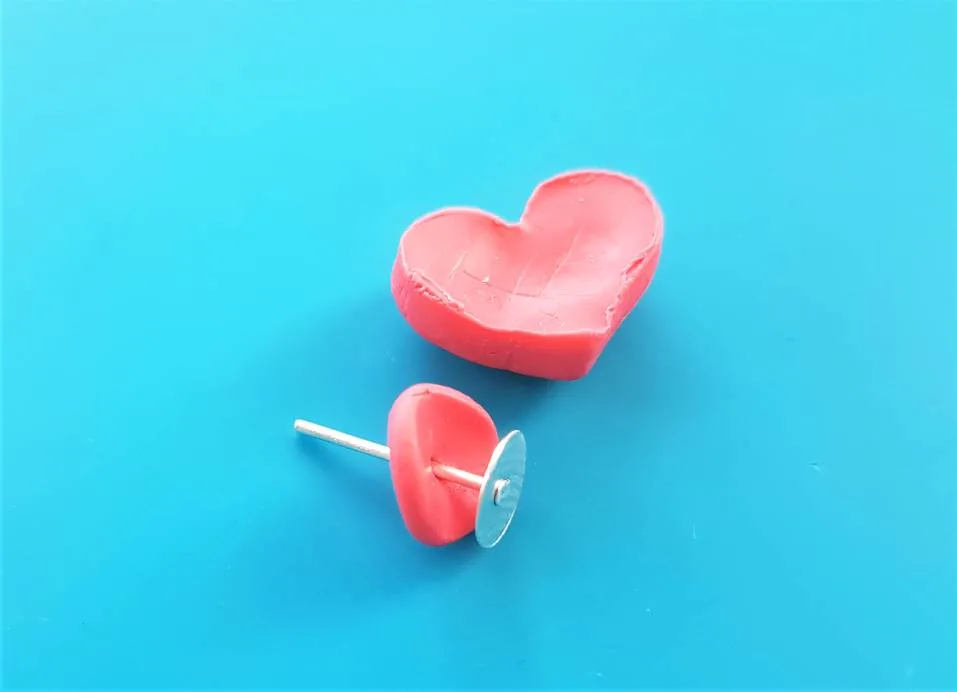
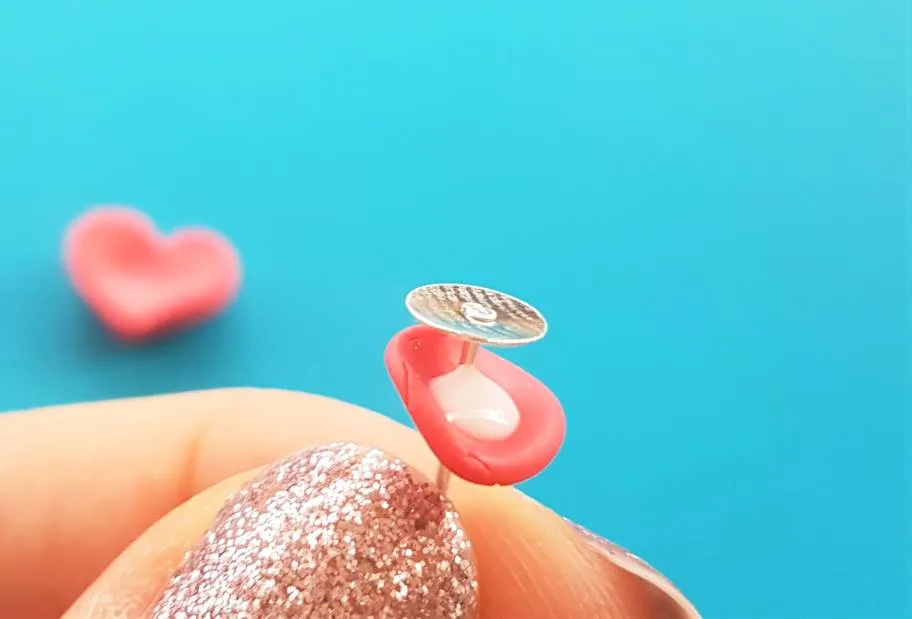
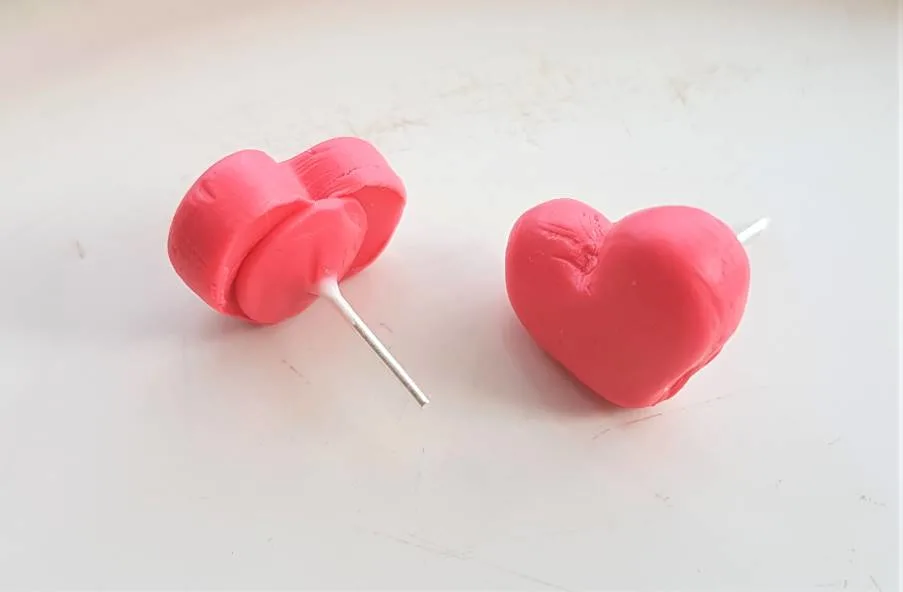
This is the strongest method I have found for attaching stud backs to earrings, for longevity and to ensure the stud back doesn’t come off after a few uses. This is called a ‘mechanical hold’.
There are several other methods for attaching earring backs, including super gluing them on which is great for speed, especially when batch making, and many have no trouble with their earring backs popping off, but I’m a tiny bit paranoid, so I always create a mechanical hold.
For a full guide to attaching stud backs, including the differing methods, check out:
How to Attach Stud Backs to Polymer Clay Earrings
Now the stud back is attached we need to bake the earrings to activate the polymer clay glue, and cure the clay…
5. Bake the stud earrings
It’s time to bake the earrings.
Here’s how to do it:
- Put your earrings onto a plate and carry them to the oven, to avoid last minute finger prints
- Set your oven temperature according to the packaging instructions of your chosen brand of clay
- Prepare a baking tray for your earrings to cure on – it’s best not to use the same tray for food, and to line it with a baking sheet
- Wait for the oven to heat to temperature, then put the earrings in
- Allow the earrings to bake to time and then remove them from the oven and place them back on the plate
- Allow the earrings to cool and sufficiently harden, before moving onto the next step
Be careful when baking the clay, as sometimes the side touching the baking paper can cure with a bit of a glossy finish. It’s no problem if you’re varnishing the designs for a shiny finish afterwards, as we are here, but for other projects keep this in mind.
A way to avoid the unwanted glossy finish from the baking sheet is to bake your design in a little mound of cornflour. Don’t worry, the cornflour brushes off easily when you remove it from the oven. This is also a great way of baking 3D designs, so one side doesn’t flatten against the baking sheet, and the whole thing is suspended in the mound, if that makes sense.
Here’s an A-Z break down of individual brands and their baking time, so you have a quick guide to hand:
Cernit: 30 minutes between 110 and 130°C (230-266°F)
Fimo: Maximum of 30 minutes at 110°C (230°F)
Kato Polyclay: 10-30 minutes at 150°C (300°F)
Original Sculpey: 15 minutes per quarter inch (6mm) of thickness at 130°C (275°F)
Pardo Art Clay: Min 30 minutes at 120 decrees (248 F)
Pardo Translucent Jewellery clay: Min 30 minutes at 120°C (248°F)
Premo: 30 minutes per quarter inch (6mm) of thickness. If thicker, initially bake for 15 minutes and then add another 5 minutes, another 5, and so on until done.
PVClay: 15-20 minutes at 130°C (275°F)
Sculpey III: 15 minutes per quarter inch (6mm) of thickness at 130°C (275°F)
Sculpey Souffle: 30 minutes per quarter inch (6mm) of thickness at 130°C (275°F)
Super sculpey: 15 minutes per quarter inch (6mm) of thickness at 130°C (275°F)
Once baked, you can tell if the earring piece is done if it’s still bendy, but not brittle. It’s fine if it’s bendy, don’t worry, it will cool and harden after some time.
It’s best to create a test piece to bake alongside your earrings in the oven, that you can bend and mess around after baking with to ensure your earrings are done.
Different brands of clay will react differently in each oven, so running test pieces are a great way to get to know how your clay behaves with your appliance. It’s also great to use an oven thermometer, to double check you have the temperature setting right (sometimes the oven dial can be a little unreliable, and if you’re batch making earrings you want everything to be precise, to ensure they properly cured).
Now your clay earrings have cooled (I do suggest waiting a few hours), it’s time to varnish the designs…
6. Varnish the polymer clay stud earrings
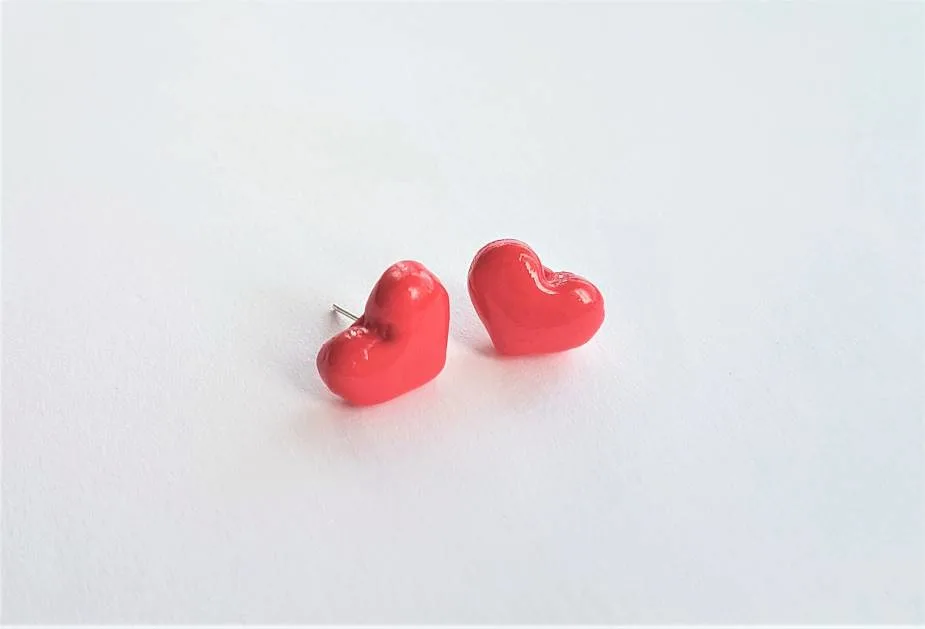
Varnishing the designs will add a great shiny touch to the earrings, allowing them to stand out with a pretty finish.
Varnishing also adds a hardened layer to the design, which can serve as a protective barrier, adding strength and a waterproof finish.
Please note, varnishing won’t completely waterproof your designs, and they shouldn’t ever be submerged in water.
Here are my tips for varnishing, along with a step-by-step guide:
- First, ensure you have your polymer clay varnish to hand
- Ensure you have a good quality brush to apply your varnish with, that won’t shed it’s bristles or leave streaks over your design
For help choosing a varnish brand, and for more tips, I have a guide here.
- Next apply two to three layers of varnish to your design – don’t do too many as the varnish may end up looking cloudy
- Place your earrings somewhere they can dry, without allowing the varnish to touch any surface – skewering them in something via the stud stem would work best, like a binder
- Allow the varnish to fully dry, according to the packaging instructions of your chosen brand of varnish
Now your varnish has dried, take your earrings and apply the butterfly stud fastening and they are complete.
Let’s move on to packaging and storing them, which is really important – you want to make sure you take care of your earrings, especially if they are a product to sell, otherwise if they get damaged or dusty your hard work making them will be for nothing…
7. Package and store the polymer clay stud earrings

Your designs are made, and now it’s time to properly package and store them.
Packaging
You want to ensure all of your earrings are kept on earring cards, like mine pictured above, and additionally sealed in a cellophane wrap – if you are selling them that is. Sealing them like this will protect them from dust, lint, fur and any other bits and bobs that may end up dirtying them over time. Even if they are kept in a plastic storage drawer I still like to package them like this, so they are pristine for sale.
I also like to add a branded sticker to the earring card, as it adds a flare of design and I think it looks really cute. Buying a few sheets of branded stickers is really easy; there are many seller on Etsy and other stores that will allow you to send them an image to print on a sheet of stickers.
I mocked up a little egg character on Inkscape (free graphic design software) for my branded sticker, and had two sheets printed by an Etsy store. I think it cost me two pounds in total, for thirty or more stickers – great deal!
Storage
It’s best to store your polymer clay earrings away from sunlight, as the sun will bleach the colours of your clay over time, and in a plastic storage drawer (wood or metal won’t work as they can get too hot or dry out any unbaked clay).
You need to look for the correct type of plastic, that won’t interreact with the clay.
Top tip: to tell if something is the correct plastic, flip it over and look for the markings on the bottom. There should be the number five in a triangle on the underside.
Have a separate drawer for unbaked clay and baked clay, as storing them together will weaken the integrity of your baked designs. This is due to the oils of the unbaked clay saturating the porous surface of the baked clay, making it weak and flexible again. The effect won’t be immediate, but it will happen over time, so it’s best practice to always keep them apart.
That’s how to properly package and store your clay… now for some answers to related questions that may help you out.
Related questions
Are polymer clay earrings heavy?
Small to medium sized polymer clay earrings are not heavy, as baked polymer clay is a lightweight material.
Does polymer clay break easily?
Properly cured polymer clay does not break easily although it will be bendy under pressure. Too much stress will eventually snap the earrings, however with proper care the earrings should stay strong through years of use.
Can you bake earring studs?
Earring studs can be baked at the same temperature you bake your polymer clay. It’s best to bake the stud into the clay as opposed to gluing it on afterwards, as this will make for a stronger hold.
Conclusion
I hope you found my ‘How to Make Polymer Clay Stud Earrings – Beginner’s Guide’ article helpful and you now feel confident to give making polymer clay stud earrings a go for yourself. The possibilities are endless, and the creative designs are only limited to your imagination.
Have fun experimenting with colours and cutters, and before you know it you’ll have made a polymer clay stud earring collection to sell on Etsy.
It’s my goal to make the world of polymer clay earring making as fun and easy as possible for beginners. I’ve complied many guides, such as the below, for more information:
A How-to Guide to make polymer clay earrings for beginners, a Sales Guide for selling polymer clay earrings on Etsy, a comprehensive Cost Guide, and a bumper list of earring Design Ideas, so you’re never stumped by clay-makers block!

Lorna is a footwear geek and the founder of Wearably Weird. She created a YouTube channel in 2021 for fellow footwear fanatics, dedicated to detail-rich footwear reviews and info. She has a fashion media qualification (awarded in 2011).
